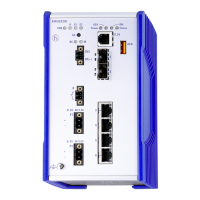Routing > OSPF > Diagnostics
Routing
340
RM GUI HiSecOS EAGLE20/30
Release
3.0
09/2015
8.17.4 Virtual Neighbors
OSPF requires a continuous connection of the Autonomous System
backbone area. OSPF also requires that every area has a connection to the
backbone area. The physical location of routers often prohibits an area from
directly connecting to the backbone area. Virtual links allow you to connect
physically separated areas to the backbone area.
The ABRs of the backbone area and the physically separated area form a
point-to-point link through a transit area. When the ABRs establish an
adjacency, then the backbone router LSAs include the link and OSPF
packets flow over the virtual link. Furthermore, the routing database of each
endpoint router includes the link state information of the other endpoint
router.
Note: The OSPF allows you to specify virtual links through every type of area
except for stub areas.
Table
Parameters Meaning
Area ID Displays the transit area ID of the virtual link.
OSPF allows you to specify virtual links from an ABR of an area separated
from the backbone area through transit areas directly linked to an ABR in
backbone area.
Possible values:
transit area IDs
Router ID Displays the router ID of the other virtual endpoint ABR.
After virtual adjacencies form, the virtual link carries OSPF packets such as
hello packets and LS update packets containing database information.
When the LSAs of the neighbor router contain the router ID of the local
router.
Possible values:
router ID

